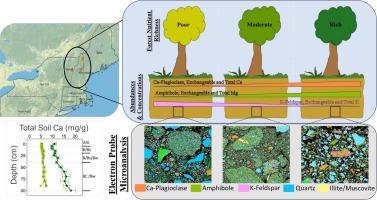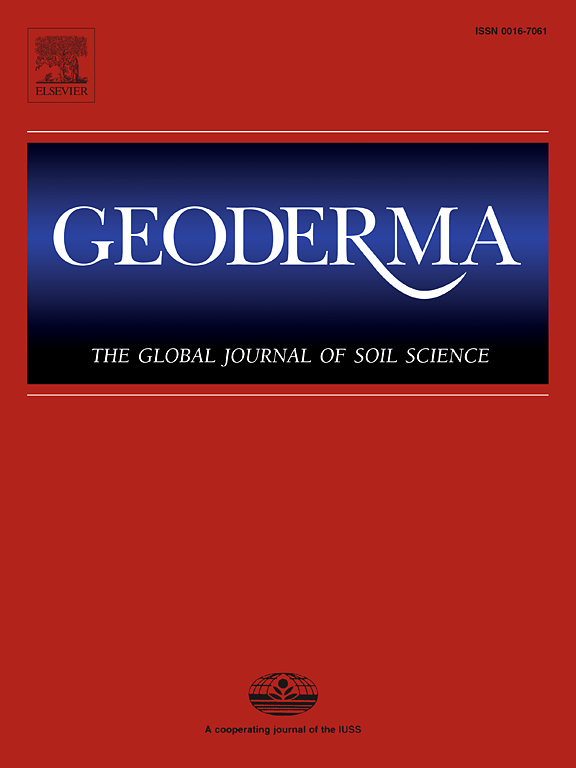母质矿物学对跨养分富集梯度的森林土壤养分释放率的影响
IF 5.6
1区 农林科学
Q1 SOIL SCIENCE
引用次数: 0
摘要
尽管母质矿物学对可持续森林管理非常重要,但人们对母质矿物学对木材生产林养分释放率的影响仍然知之甚少。本研究调查了母质矿物学如何影响土壤养分丰度和释放率。我们对佛蒙特州和新罕布什尔州的三片森林进行了研究,研究范围跨越了土壤母质中钙和镁的富集梯度。我们发现,可交换养分和总养分浓度均随养分富集度梯度而变化,富集地的可交换钙浓度最高(758 毫克/千克),贫瘠地的可交换钙浓度最低(51.3 毫克/千克)。富饶(41.5 毫克/千克)和中等(42.9 毫克/千克)地区的可交换镁浓度高于贫瘠(7.04 毫克/千克)地区。富饶地区的钙总浓度最高(13 毫克/克),而中等地区(5.73 毫克/克)和贫瘠地区(5.89 毫克/克)的钙总浓度较低。镁的总浓度在富集区(27.3 毫克/克)高于中度富集区(9.47 毫克/克)和贫瘠区(3.07 毫克/克)。通过将整个土壤剖面中的τ值与母质进行比较,我们发现所有三片森林上部 30 厘米处的钙、镁和钾含量都处于中度至轻度贫瘠状态,但由于生物隆升,钾含量略有富集。此外,我们还发现,计算得出的野外养分释放率在不同森林养分状况下没有显著差异(p > 0.05),这表明不同母质的影响有限。我们还用有机酸(氯化钠、邻苯二酚和柠檬酸)在不同的 pH 值条件下(4、5、6)进行了批量反应器实验。不出所料,与 pH 值为 5(1.27 毫克/平方米/天)和 pH 值为 6(0.888 毫克/平方米/天)的土壤相比,pH 值为 4 的土壤镁释放率最高(2.19 毫克/平方米/天),但令人惊讶的是,钙释放率却没有受到影响。我们的研究结果凸显了母质矿物学对钙和镁释放率的主要影响,同时也表明原生矿物质的风化可以维持森林生态系统的生产力。本文章由计算机程序翻译,如有差异,请以英文原文为准。

Influence of parent material mineralogy on forest soil nutrient release rates across a nutrient richness gradient
The influence of parent material mineralogy on nutrient release rates in wood production forests remains poorly understood, despite its importance for sustainable forest management. This study investigated how parent material mineralogy impacts soil nutrient abundance and release rates. We studied three forests in Vermont and New Hampshire across a Ca and Mg richness gradient within the soil parent material. We found that both exchangeable and total nutrient concentrations followed the nutrient richness gradient with exchangeable Ca concentrations highest at the rich (758 mg/kg) and lowest at the poor (51.3 mg/kg) sites. Exchangeable Mg concentrations were higher at the rich (41.5 mg/kg) and moderate (42.9 mg/kg) sites relative to the poor (7.04 mg/kg) sites. Total concentrations of Ca were highest at the rich sites (13 mg/g) compared to the moderate (5.73 mg/g) and poor (5.89 mg/g). Total Mg concentrations were higher at the rich (27.3 mg/g) than the moderate (9.47 mg/g) and poor (3.07 mg/g) sites. Using τ values throughout the soil profile compared to the parent material, we found that all three forests were moderate to weakly depleted in Ca, Mg, and K in the upper 30 cm, but P was slightly enriched due to biological uplift. Additionally, we found that calculated field nutrient release rates did not significantly differ among forest nutrient status (p > 0.05), indicating the limited effects from across parent materials. We also conducted a follow up batch reactor experiment at varying pH conditions (4, 5, 6) with organic acids (NaCl, catechol, and citric acid). As expected, pH 4 had the highest Mg release rate (2.19 mg/m2/day) compared to pH 5 (1.27 mg/m2/day), and pH 6 (0.888 mg/m2/day), but surprisingly no effect on Ca release rates, suggesting the more acidic soils of the base cation poor soils results in higher release rates. Our results highlight the dominant contributions of parent material mineralogy has on Ca and Mg release rates, but also that weathering of primary minerals can sustain forest ecosystem productivity.
求助全文
通过发布文献求助,成功后即可免费获取论文全文。
去求助
来源期刊

Geoderma
农林科学-土壤科学
CiteScore
11.80
自引率
6.60%
发文量
597
审稿时长
58 days
期刊介绍:
Geoderma - the global journal of soil science - welcomes authors, readers and soil research from all parts of the world, encourages worldwide soil studies, and embraces all aspects of soil science and its associated pedagogy. The journal particularly welcomes interdisciplinary work focusing on dynamic soil processes and functions across space and time.
 求助内容:
求助内容: 应助结果提醒方式:
应助结果提醒方式:


